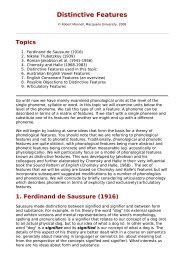The Syllable and the Foot : Summary - Speech Resource Pages
The Syllable and the Foot : Summary - Speech Resource Pages
The Syllable and the Foot : Summary - Speech Resource Pages
You also want an ePaper? Increase the reach of your titles
YUMPU automatically turns print PDFs into web optimized ePapers that Google loves.
get a good idea of what types of syllable structure are legal in<br />
English.<br />
a) Open syllables<br />
V "I" /ɑe/<br />
CV "me" /miː/<br />
CCV "spy" /spɑe/<br />
CCCV "spray" /spræe/<br />
b) Closed syllables<br />
VC "am" /æm/<br />
VCC "ant" /ænt/<br />
VCCC "ants" /ænts/<br />
CVC "man" /mæn/<br />
CVCC "bond" /bɔnd/<br />
CVCCC "b<strong>and</strong>s" /bændz/<br />
CVCCCC "sixths" /sɪksθs/<br />
CCVC "brag" /bræɡ/<br />
CCVCC "brags" /bræɡz/<br />
CCVCCC "plants" /plænts/<br />
CCCVC "spring" /sprɪŋ/<br />
CCCVCC "springs" /sprɪŋz/<br />
CCCVCCC "splints" /splɪnts/<br />
It is clear from this list that English has a very flexible syllable<br />
structure. <strong>The</strong>re are languages at <strong>the</strong> opposite extreme that have<br />
only CV syllables.<br />
It should be noted, however, that <strong>the</strong>re are never<strong>the</strong>less<br />
considerable constraints on which phoneme sequences are<br />
permissible in English syllables. Such constraints are called<br />
phonotactic constraints <strong>and</strong> <strong>the</strong>se constraints are very languagespecific.<br />
Never<strong>the</strong>less, <strong>the</strong>re is a universal tendency for phonotactic<br />
constraints to conform mostly to sonority profile constraints.
















